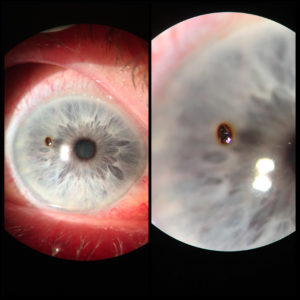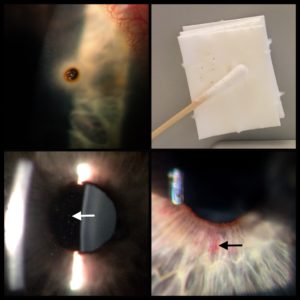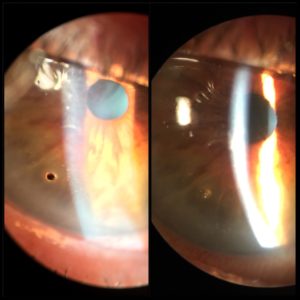alias: Corpus alienum cornae
Foreign body gets in the cornea most often during cutting/grinding of metal with angle grinder. During this work hot sparks (respectively hot small pieces of metal) fly away and eyesily get into the eye and stuck on/in it´s surface. Usually they don´t have sufficient kinetic energy to penetrate it´s whole wall (although exceptions confirm the rule). Another common occasion how to get the corneal foreign body is drilling of metal or spot welding. By children we can see the corneal foreign bodies too (occasionally) – usually swinging on the rusty swing precedes.
Sometimes immediately, sometimes with a delay of a few days, the eye becomes red, pains, photophobia is present. The pain is often localized under the upper eyelid. This condition, because it is not very comfortable, usually brings the patient soon to the doctor.
The doctor extracts the foreign body in the topical anesthesia (with eyedrops), gives the patient antiseptic or antibiotic oinment and covers the eye with sterile dressing. The patient continues a few days with application of that oinment. The check up is usually needed only in infected wounds, if the foreign body´s localisation was central, or if there is a bigger inflammation of the eye.
If the foreign body is in the cornea less than 3 hours, the extraction is usually easy. The foreign body is solid, the rust didn´t have time to get into the corneal tissue. The metalic foreign body is originally usually a spark – so sterilized by heat. The healing in this case is usually also without complications.
If the foreign body is in the cornea longer time, the extraction is more complicated. The foreing body becomes crumbly. The rust from the metal (usually iron) penetrates into the corneal tissue. Corneal tissue becomes jelly-like. It is more difficult to remove all parts of the foreign body. Secondary infection can be present. If the extraction is too difficult, it is sometimes better to leave some residual rust in the cornea and clean up the rest a few days later (2-3 days) – then the consistence of the tissue is better (but the patient has to be covered with antiseptic/antibiotic oinment during that waiting).
Sometimes is foreing body in the cornea quite long time – one week and even more (patient just doesn´t have to notice, that there is something in the eye). In that case the extraction is usually also quite easy (because the body is already demarcated by body´s healing processes). But i can´t advice to keep the foreing body in the eye longer intentionally – because there is quite high risk of infection and of the ocular inflammation.
People sometimes do the home-extraction of the foreign bodies (with toothpick, corner of handkerchief etc.). This can be dangerous (risk of infection). And also it is not very comfortable (without anesthesia – don´t forget, that cornea is the most sensitive part of the human body). In the topical anesthesia in the doctor´s office is extraction painless and quick – so it looks senseless to do it at home.

Two days old corneal foreign body. In the right picture we can notice the rust penetrating into the corneal tissue – this tells us, that the extraction will be more difficult.

Corneal foreign body with inflammation. In the upper left picture you can see grayish inflammatory halo around the foreign body. In the lower left picture are visible inflammatory cells in the anterior chamber. In the lower right picture you can see dilated vessels of the iris due to inflammation. Upper right picture shows particles of the foreign body after extraction (it was already crumbling).

In the left picture we can see corneal foreign body, that is there for longer time. It is already almost separated from the cornea. In the right picture is the wound after it´s easy removal by cotton swab.